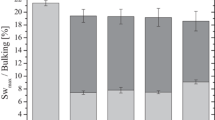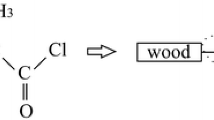Abstract
This study evaluated the combined modification and staining of ash, beech and maple wood with a low molecular weight N-methylol melamine compound (NMM) and a metal-complex dye. Wood samples were treated with aqueous solutions of 10, 20 and 30 wt% NMM and 5 wt% of the dye. The treatment caused the fixation of the water-soluble dye by the NMM resin. Vacuum pressure impregnation of unsealed wood blocks did not result in different solution uptake and weight percent gain after curing among the three species, but sealing of the surfaces of the wood blocks to allow penetration only into one direction revealed easiest penetrability of beech followed by maple and ash. UV micro-spectrophotometry and light microscopy indicated that NMM was partly deposited in the cell wall and partly in the lumens. Penetration of the metal-complex dye was shown by means of X-ray micro-analysis (SEM–EDX). The study shows that a combined resin modification and staining of the three wood species tested is possible and that NMM causes fixation of the water-soluble dye.






Similar content being viewed by others
References
Devallencourt C, Saiter JM, Capitaine D (2000) Reactions between melamine formaldehyde resin and cellulose: influence of pH. J Appl Polym Sci 78:1884–1896
Fergus BJ, Goring DAI (1970) The location of guaiacyl and syringyl lignins in birch xylem tissue. Holzforschung 24:113–117
Gindl W, Dessipri E, Wimmer R (2002) Using UV-microscopy to study diffusion of melamine-ureaformaldehyde resin in cell walls of spruce wood. Holzforschung 56:103–107
Gindl W, Mueller U, Teischinger A (2003a) Transverse compression strength and fracture of spruce wood modified by melamine formaldehyde impregnation of cell walls. Wood Fiber Sci 35:239–246
Gindl W, Zargar-Yaghubi F, Wimmer R (2003b) Impregnation of softwood cell walls with melamine-formaldehyde resin. Bioresour Techn 87:325–330
Hansmann C, Deka M, Wimmer R, Gindl W (2006) Artificial weathering of wood surfaces modified by melamine formaldehyde resins. Holz Roh Werkst 64:198–203
Hill CAS (2006) Wood modification, chemical, thermal and other processes. Wiley, Chichester
Inoue M, Ogata S, Nishikawa M, Otsuka Y, Kawai S, Norimoto M (1993) Dimensional stability, mechanical properties and color changes of a low molecular weight melamine formaldehyde resin impregnated wood. Mokuzai Gakkaishi 39:181–189
Janin G, Goncalez J, Ananías R, Charrier B, da Silva FG, Dilem A (2001) Aesthetics appreciation of wood colour and patterns by colorimetry. Part 1. Colorimetry theory for the CIELAB system. Maderas Cienc Technol 3(1–2):3–13
Kleist G, Schmitt U (1999) Evidence of accessory compounds in vessel walls of Sapelli heartwood (Entandrophragma cylindricum) obtained by transmission electron microscopy. Holz Roh Werkst 57:93–95
Koch G, Grünwald C (2004) Application of UV microspectrophotometry for the topochemical detection of lignin and phenolic extractives in wood fibre cell walls. In: Schmitt U et al (eds) Wood fibre cell walls: methods to study their formation, structure and properties. Swedish University of Agricultural Sciences, Uppsala, pp 119–130
Koch G, Kleist G (2001) Application of scanning UV microspectrophotometry to localise lignins and phenolic extractives in plant cell walls. Holzforschung 55:563–567
Krause A, Hof C, Militz H (2004) Novel wood modification processes for windows and cladding products. Proceedings of 35th annual meeting on the international research group on wood preservation. Slovenia. IRG/WP 04-40285
Lukowsky D (1999) Holzschutz mit Melaminharzen. PhD thesis, University of Hamburg
Miller ER, Boxall J (1984) The effectiveness of end-grain sealers in improving paint performance in softwood joinery. Holz Roh Werkst 42:27–34
Norimoto M, Gril J (1993) Structure and properties of chemically treated woods. In: Shiraishi N, Kajita H, Norimoto M (eds) Recent research on wood and wood-based materials. Elsevier, Barking, pp 135–154
Pittman CU, Kim MG, Nicholas DD, Wang L, Kabir FRA, Schultz TP, Ingram LL (1994) Wood enhancement treatments I. Impregnation of southern yellow pine with melamine formaldehyde and melamine-ammeline-formaldehyde resins. J Wood Chem Technol 14(4):577–603
Rapp AO, Peek RD (1999) Melaminharzimprägniertes so wie mit Wetterschutzlasur oberflächenbehandeltes und unbehandeltes Vollholz während zweijähriger Freilandbewitterung. Holz Roh Werkst 57:331–339
Rapp AO, Bestgen H, Adam W, Peek RD (1999) Electron energy loss spectroscopy (EELS) for quantification of cell-wall Penetration of a melamine resin. Holzforschung 53:111–117
Rowell RM (2005) Moisture properties. In: Rowell RM (ed) Handbook of wood chemistry and wood composites. CRC Press, USA
Sint KM, Adamopoulos S, Koch G, Hapla F, Militz H (2013) Impregnation of Bombax ceiba and Bombax insigne wood with a N-methylol melamine compound. Wood Sci Technol 47:43–58
Spurr AR (1969) A low-viscosity epoxy resin embedding medium for electron microscopy. J Ultrastruct Res 26(1–2):31–43
Stamm AJ (1964) Wood and cellulose science. Ronald Press Company, New York
Thuvander F, Kifetew G, Berglund LA (2002) Modeling of cell wall drying stresses in wood. Wood Sci Technol 36(3):241–254
Acknowledgments
The authors express their appreciation to Tanja Potsch and Karin Brandt for their valuable help during the sample preparation and the actual measurements conducted at the Institute for Wood Technology and Wood Biology, Federal Research Institute of Rural Areas, Forestry and Fisheries (vTI), Hamburg, Germany.
Author information
Authors and Affiliations
Corresponding author
Rights and permissions
About this article
Cite this article
Kielmann, B.C., Adamopoulos, S., Militz, H. et al. Modification of three hardwoods with an N-methylol melamine compound and a metal-complex dye. Wood Sci Technol 48, 123–136 (2014). https://doi.org/10.1007/s00226-013-0595-y
Received:
Published:
Issue Date:
DOI: https://doi.org/10.1007/s00226-013-0595-y




